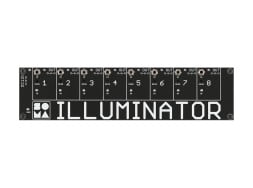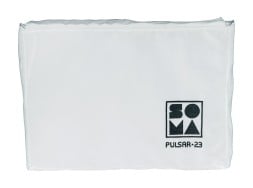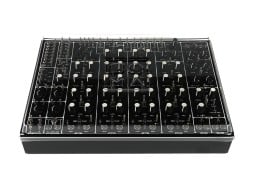SOMA LaboratoryPulsar-23 Semi-Modular Drum Machine
-
 Free
Free
Shipping -
 No Hassle
No Hassle
Returns -
 Extended
Extended
Warranty -
 Low Prices
Low Prices
Guaranteed
SOMA Laboratory Pulsar-23
From experimental breakbeats to grooves beyond the grid, the Pulsar-23 Semi-Modular Drum Machine from SOMA Laboratory shatters traditional conceptions of what a drum machine can do. Because it is semi-modular, no patching is required to make sound right out of the box; however, the wealth of inter- and intra-connectivity and its truly open-ended architecture make the Pulsar-23 an ideal companion for rhythmic experimentation and sonic discovery well beyond its default connections.
As far as internal patching goes, the Pulsar-23 does away with traditional 1/8" or 1/4" cables in favor of alligator clips and binding posts. This has two benefits straight away—1) connecting multiple clips on a single post is easy, and 2) you can also make connections between the binding posts using your hands, making your body a part of the instrument! Don't worry about connecting things wrong and breaking something; the inputs automatically mix multiple incoming signals, and many binding posts on the Pulsar-23 can function as either inputs or outputs depending on which signals are patched into them. In this way audio, clock, and modulation signals can be swirled together in what Soma calls the "organismic": the complex, interwoven, and nonhierarchical systems of relation between constituent parts characteristic of natural systems, utopian societies, and neural networks.
In terms of specs, the Pulsar-23 features four voices, each with its own characteristics and applications. These are: BD (bass drum), BASS (a fully-featured subtractive monophonic bass synth), SD (snare/clap), and HHT (hi-hat/cymbal). Each of the voices have both common and unique controls that vary from voice to voice. An attack/release envelope, volume level, and FX send grace each of the voices. BD features a drive control for waveshaping, while the other voices each have a filter type that corresponds to their sonic characteristics: low pass filter for BASS, band pass filter for SD, and a high pass filter for the HHT. FX sends on every channel control the amount of the signal that passes through to the DSP FX section. Furthermore, the BASS module can also be configured as an additional percussion instrument with the flip of a switch, turning the Pulsar-23 into a quartet of percussive voices. Each voice's A/D envelope also has its own binding post, useful for sidechaining and other interdependent patches: for instance, with one alligator clip connection, the bass drum's envelope could modulate the cutoff of the snare/clap's filter.
An optional distortion unit can be applied to the main mix output, with manual control over drive level and dry/wet mix. The resulting sounds range from pleasantly overdriven to pulverized, especially when combined with the Pulsar-23's characterful delay and reverb units. Delay modes include 1-tap, 2-tap, dual, and pitch-shift, while the reverb offers a couple of variations on a classic "hall" sound. These effects can be configured as either two separate channels, one for each effect, or routed in a stereo configuration, with both stereo and delay passing through both channels. Many FX parameters are under voltage control, including the delay time and feedback level, as well as the clock speed of the A-D converters, allowing you to introduce additional pitch-shifting and aliasing artifacts into your drum tracks with CV!
Soma took a unique approach to sequencing with the Pulsar-23. Instead of a linear step-sequencer, the sequencer is more akin to a sort of tape loop which records the beginning and end of musical events. Pressing on the dedicated pads at the bottom of each voice adds a note to the sequencer, with both the start time and length of press recorded. The recording resolution is highly accurate, meaning the sloppiest J Dilla-esque micro-timed claps and hats are fully in reach, while a per-voice rhythmic quantiser can be applied to lock any of the four voices into a grid. Users can save and recall four banks of four sequences, one for each voice. In addition, the Pulsar-23 features robust MIDI implementation—assign MIDI messages to drum parameters with the learn function, or patch anywhere from the four MIDI to CV binding posts. The BASS module can be fully controlled via MIDI, separately from the other three voices, with good 1 volt-per-octave tracking over about five octaves.
Pulsar-23's internal tempo can be overridden via MIDI or analog clock, allowing you to easily sync the Pulsar with external devices. Whether clocked internally or externally, the Pulsar-23's clock section produces seven unique clock divisions: patch these to individual drum trigger inputs, LFO sync, or anywhere else in the system for synchronized control, or self-patch the clock divisions to one another to create lilting, skronky swing patterns. The wide frequency range of the LFO spans from 0.1Hz–5000Hz, far into the reaches of the audio spectrum. Control the frequency of the LFO with external CV and sync it to other signals for clock-synced modulation.
"Shaos" adds another level of unpredictability to the Pulsar-23. This pseudo-random voltage generator uses shift registers and a sample and hold circuit to create sequences of stepped voltages. These patterns come in three flavors, 1-bit with two states, 2-bit with four states, or 3-bit with eight possible states. The length of the pseudo-random sequencer is selectable between 63, 16, and 217. In the 16-step mode, the data pin accepts signals to seed data into the shift register and create short looping patterns. Naturally, the "Shaos" module can also be synced to your master clock source.
In addition to these exciting features, a number of utility functions are available for use. These round out the Pulsar-23, adding essential functions typically found in more extensive modular systems. Four attenuators add depth control to parameters that may lack them due to space constraints, and the two VCAs accept audio or CV signals for dynamic variation. CV controllable inverters, gate-controlled electronic switches, triggered impulse generators, and common electronic components such as diodes and capacitors are surprising and useful additions. And of course, you can connect any Pulsar binding post to external modular devices with any of its eight 1/8" (3.5mm) or six 1/4" two-way adaptors—making it easy to work the Pulsar-23 into your personal modular ecosystem.
This organismic drum machine is unlike any other. From the versatile drum voices to the unique sequencer, to the wealth of modulation sources, alligator clip connections, and robust MIDI implementation, the Pulsar-23 shines and sizzles in both live and studio contexts.
Pulsar-23 Features
- Organismic semi-modular drum machine
- Alligator clip and binding post patching interface
- Four unique drum voices: BD, BASS, SD, and HHT
- Unique four-channel tape looper-style sequencer
- "Shaos" pseudo-random voltage generator with multiple step lengths
- Digital delay and reverb effects with CV over most parameters, including DSP clock rate
- Facilitates circuit bending using internal and external connections
- Deep MIDI integration: MIDI learn on many drum parameters, MIDI pitch tracking on BASS voice, four assignable MIDI-to-CV converters
- Internal or external clock with 7 unique clock divisions
- Optional distortion on final output
- Main output volume control
- Eight two-way 1/8" (3.5mm) and six two-way 1/4" adaptors for use with external modular devices
- Two VCA for processing audio or CV
- Inverters, switches, electrical components, and pulse transformers
- Four attenuators
- Two touch-sensing CV sources
- Wide-ranging VCLFO with sync input and variable waveform
- Includes 30 alligator clips, power supply, and high-quality handmade carrying bag
- Input and output range: 0-10V
- Seven 1/4" TS jacks: 6 two-way assignable + 1 dedicated main output
- Eight 1/8" (3.5mm) TS two-way assignable jacks
- 1/8" (3.5mm) TRS headphone output
- MIDI input: 5-pin DIN MIDI
- 12V power supply (included)
- 380 x 280 x 80mm/15 x 11 x 3"
 Artist Picks: Best Gear of the Year 2022Synthesizers, Drum Machines, Effect Pedals, Eurorack Modules, and More!Best Drum Machines of 2020Semi-Modular, DSP, Trackers, and MoreThe Long Hum: a Deep Dive into the Ephemeral World of DroneFrom Mystical Origins to Modern Drone MachinesBuying Guide: Drum MachinesAffordable Favorites, Outrageous Oddities, and Hard-Hitting Modern ClassicsRethinking Eurorack: Keeping it in the Rack...or NotSome Not-So-Holistic Approaches to the Modular Synthesizer
Artist Picks: Best Gear of the Year 2022Synthesizers, Drum Machines, Effect Pedals, Eurorack Modules, and More!Best Drum Machines of 2020Semi-Modular, DSP, Trackers, and MoreThe Long Hum: a Deep Dive into the Ephemeral World of DroneFrom Mystical Origins to Modern Drone MachinesBuying Guide: Drum MachinesAffordable Favorites, Outrageous Oddities, and Hard-Hitting Modern ClassicsRethinking Eurorack: Keeping it in the Rack...or NotSome Not-So-Holistic Approaches to the Modular SynthesizerAt first glance Pulsar-23 might appear to be a typical groovebox, with dedicated bass drum, bass, snare drum, and hi-hat channels and an integrated sequencer. However, it breaks past the duties of a traditional drum machine by using exposed metal bars as modular patch points—making it in many ways more like a modular synthesizer or circuit-bent sound laboratory.
With multiple internal modulation sources, gritty lo-fi effects, simultaneous CV and MIDI support, and an extremely open-ended sound architecture, the Pulsar-23 is part groovebox, part generative sound sculpture, and part industrial doom soundscape device all rolled into one.
Pulsar-23 features four channels of sound generation, each geared toward making distinct types of sounds. Capable of bass drum, bass, snare drum, and hi-hat sounds, the Pulsar-23 can create entire tracks' worth of sound—and when combined with the internal modulation sources, its gritty lo-fi effects, and extensive patchability, the Pulsar-23 becomes an entire world's worth of sonic potential, from standard beats to murky, evolving industrial textures.
It can also fit into any workflow—it makes a brilliant standalone instrument with its internal pattern recording, but can also be addressed via MIDI, CV, or even all of these methods simultaneously.
No other equipment or FX was used, exception slight limiter on common mastering.






